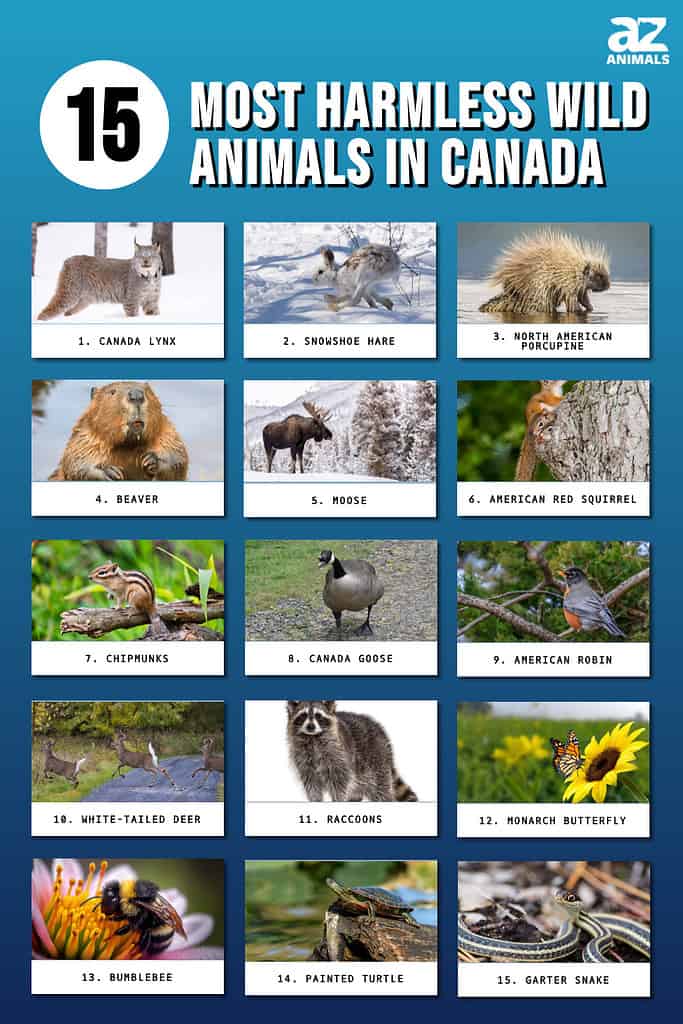
Canada is famous for its diverse and extensive wilderness, with a wide variety of wildlife. Habitats include dense forests, rugged mountains, and expansive prairies. This country is home to many majestic and fascinating animals.
Although Canada hosts different fearful predators, it has several harmless wild animals. Their calmness evokes a sense of wonder and captures the imagination. This article will help you discover the most harmless wild animals in Canada.
1. Canada Lynx
Canada lynx, or Canadian lynx, is medium sized and lives in the northern areas of the United States, Alaska, and Canada. Lynx canadensis in its scientific name. This animal has dense and long fur and triangle ears with tufts at their ends.
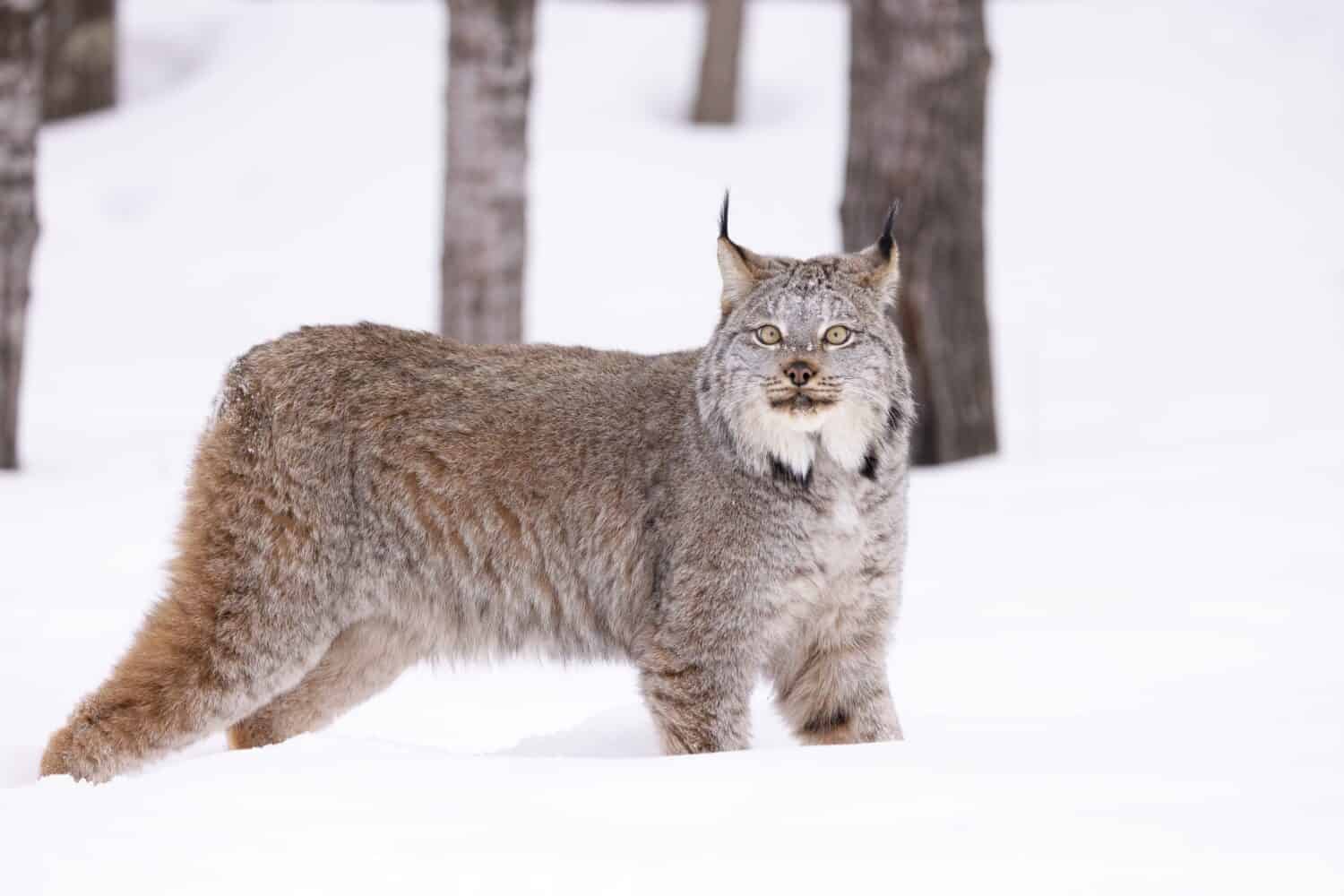
Canada lynx are gentle with no threats to humans.
©Agnieszka Bacal/Shutterstock.com
Their paws are broad, and their hind limbs are longer than their forelimbs. For this reason, their back slopes downwards towards the front. These animals are 19 to 22 inches tall and weigh approximately 18 to 24 lbs. Canada lynx are excellent climbers and swimmers. They are captivating to wildlife lovers and nature enthusiasts.
Canada lynx are gentle with no threats to humans. They stay in Canada’s mountainous and boreal forests. They have adapted to living in harsh environments. These animals are hunting experts who prey on snowshoe hares for survival.
These cats have remarkable agility and stealth for easy navigation. But you will rarely see them. Instead of confronting humans, they retreat into their habitats. These animals truly show signs of harmonious coexistence between wildlife and humans.
2. Snowshoe Hare
These rabbits camouflage themselves with brown fur in summer and spring and white fur during winter. Their underbellies are always gray, and they have black fur on the edges of their ears and tails, which are shorter than those of other species.

Snowshoe hares are common in Canada and are the most harmless wild animals.
©Jim Cumming/Shutterstock.com
Snowshoe hares, known as Lepus americanus, are common in Canada and are the most harmless wild animals. This species is common in North America, deriving their name from their large hind feet, which protect them as they hop across snow. The soles of their feet have fur for protection against freezing temperatures.
The snowshoe is common in Canadian woodlands, forests, and tundra. They are herbivorous, feeding on different plants, twigs, and bark. These hares feed on ferns, grass, and leaves in summer. While in winter, they feed on twigs, tree bark, and plants. Sometimes, you may spot these animals feeding in groups.
These animals are nocturnal and docile. They avoid confrontation with their fast movement and camouflage skills.
3. North American Porcupine
North American porcupines are also called Canadian porcupines and Erithizon dorsatum. They are large rodents with quills in their bodies and tails. Also, these rodents are the second largest in North America, with beavers as the largest.
Despite their iconic quill coat, these animals are harmless. They are fascinating, peaceful, and do not harm humans. You will find these creatures in woodlands, mountains, and forests across Canada.
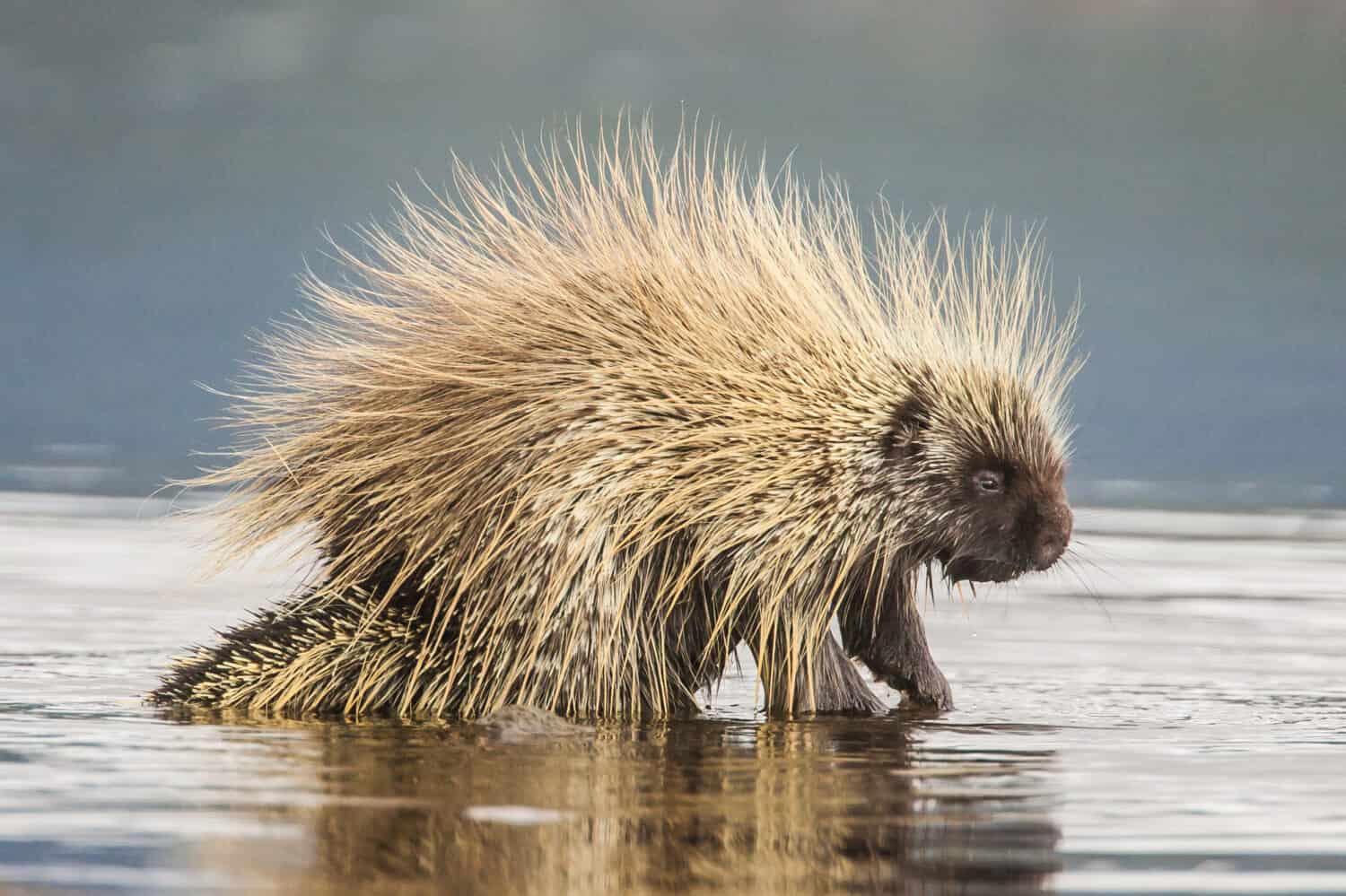
Porcupines prefer retreating to trees to avoid conflict, as they are docile animals.
©Jukka Jantunen/Shutterstock.com
They are nocturnal and feed on stems, barks, twigs, berries, and leaves at night. Also, they eat some nuts and insects. The North American porcupine has a unique defense mechanism in the form of quills.
Although many people believe porcupines shoot their quills, they don’t! Instead, they raise them to deter potential predators when threatened.
Porcupines prefer retreating to trees to avoid conflict, as they are docile animals. They swing their tail toward their attacker to lodge the spikes, which are painful and difficult to remove. However, these creatures are more interested in survival than in threatening and harming others.
They are generally harmless if you avoid unnecessary interaction and respect their space. You will have a wonderful time observing their outstanding beauty.
4. Beaver
Beavers are Canada’s national animal, known for their constructive and harmless behavior. Besides weighing up to 70 lbs., they have large heads, stout bodies, and gray or brown fur. Also, they have chisel-like long incisors, webbed back feet, hand-like front feet, and scaly flat tails.
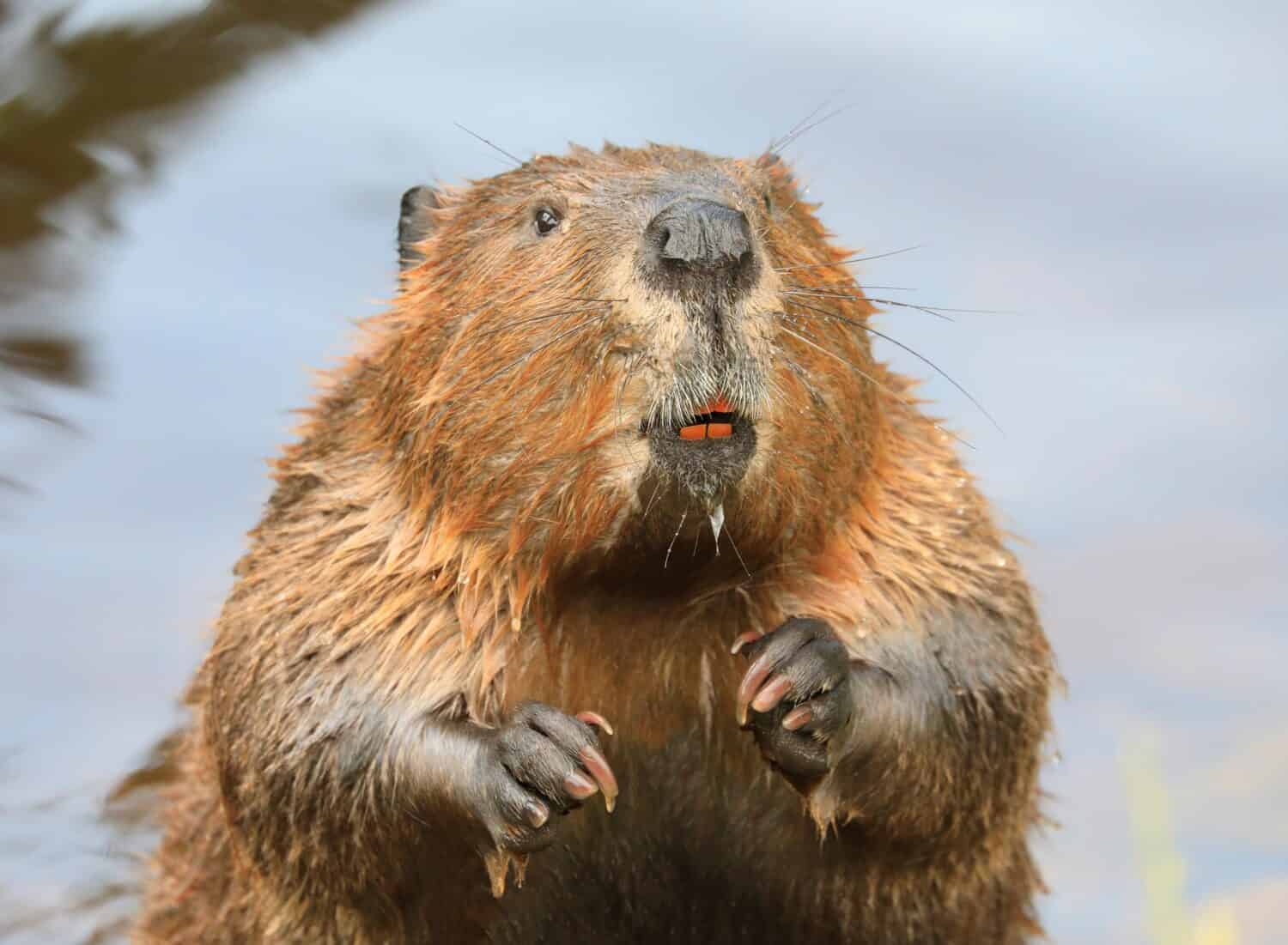
Beavers are powerful and large, but they are not aggressive, nor do they pose any threat to animals.
©Vlad G/Shutterstock.com
They are common in freshwaters like lakes, rivers, and streams. Beavers are a keystone species, meaning they have a massive effect on their surroundings and nearby species.
They are large and exist in two species: Eurasian and North American. These animals are industrious with impressive engineering skills. Besides being gentle, they have a positive contribution to their environment.
Beavers have an outstanding ability to build elaborate lodges and dams. They do this using available rocks, mud, and branches. Also, they create wetland habitats for other animals and plants, enhancing biodiversity.
Although they are powerful and large, they are not aggressive, nor do they pose any threat to animals. Their diets include aquatic plants, leaves, and bark. They are very active at night and dusk to avoid human encounters.
5. Moose
Moose or Alces alces are the heaviest and largest species in the family of deer. Male adults have broad and distinctive palmate antlers.
Despite their large size, they avoid human confrontation and are docile. These animals are common in Canada’s meadows, wetlands, and forests. They are herbivorous, with barks, shrubs, and aquatic plants making up their diet. They help to maintain the ecosystem and sustain other wildlife.
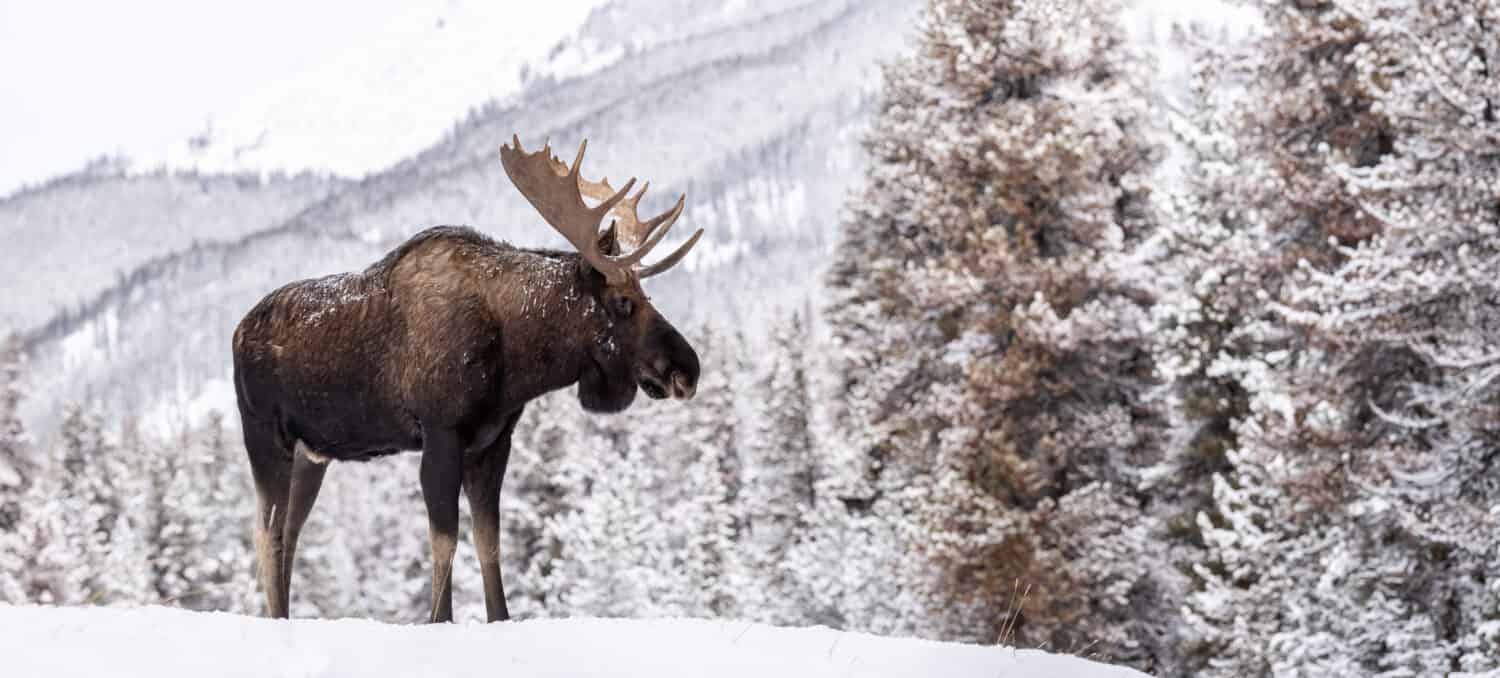
Moose are calm and prefer retreating to engaging in confrontations.
©Harry Collins Photography/Shutterstock.com
They are solitary animals apart from the mating season. During mating, males compete for females’ attention by using their antlers and size to showcase their dominance.
Moose are calm and prefer retreating over engaging in confrontations. These animals are awe-inspiring. They prove humans can coexist with majestic and peaceful creatures without disturbing or provoking them.
6. American Red Squirrel
Tamiasciurus hudsonicus is also known as chickaree, North American, or pine squirrel. These animals are small, weighing about 200 to 250 grams. They are active during the day and inactive at night and defend their territory throughout the year. You will find them in woodlands, urban areas, and forests.
They feed on various conifer seeds, nuts, and fruits. However, they prefer coniferous trees with green seeds. These animals are territorial and protective of their nesting sites and food caches, but are harmless to humans.
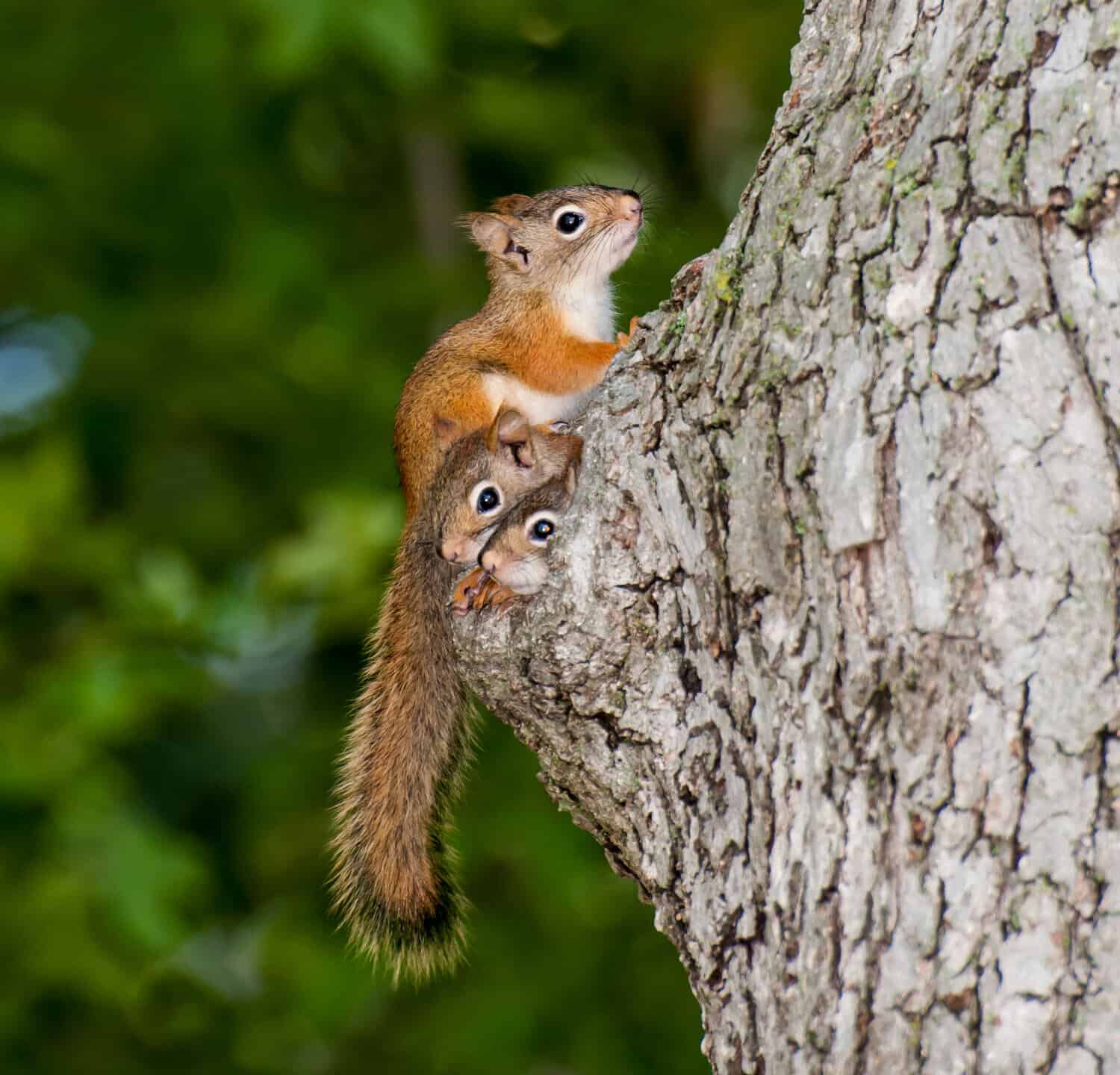
American
red squirrel
s are adorable and harmless to people.
©Michael Siluk/Shutterstock.com
However, they may give chattering and warnings. These sounds are normal communication behaviors and not a threat to humans.
Encounters with American red squirrels are fun and vibrant. You can find them gathering food, scurrying, and playing with each other. People should respect their habitats and appreciate their contributions to food dispersal.
7. Chipmunks
Chipmunks are cute small rodents from the Sciuridae family. They are common in North America except for the Siberian chipmunk, which is only common in Asia. Chipmunks are omnivorous, eating fruits, nuts, seeds, and buds. Also, they eat worms, small frogs, grass, insects, arthropods, and birds.
In human gardens, they can eat vegetables and grains, among other farm plants. They feed on ground forage and climb trees to find nuts like acorns and hazelnuts. Towards winter, chipmunks stock enough nonperishables in burrows to eat until spring.

Chipmunks are small cute rodents.
©Tatsuya Nishizaki/Shutterstock.com
Additionally, chipmunks play a vital role in the ecosystem through forest regeneration. This way, the animals’ diets are of no threat to property or humans. Also, they are harmless and nonaggressive to humans unless provoked.
Upon encounter with human beings and other large animals, they seek cover or flee. They are delightful to watch as they scamper, engaging in play and showcasing their agility. They add liveliness to any outdoor space.
8. Canada Goose
Another harmless wild animal in Canada is the Canada goose, also called Canadian goose and Branta canadensis. They are large with white cheeks, a brown body, and a black neck and head. Like most geese, they are migratory and herbivorous. You will often find them near or in fresh water. Also, you can spot them in estuaries, lagoons, marshes, and parks.
These birds are well adapted to both rural and urban environments. Normally, they display protective behavior during their nesting season. However, it is not directed to humans, but toward other geese or possible threats.
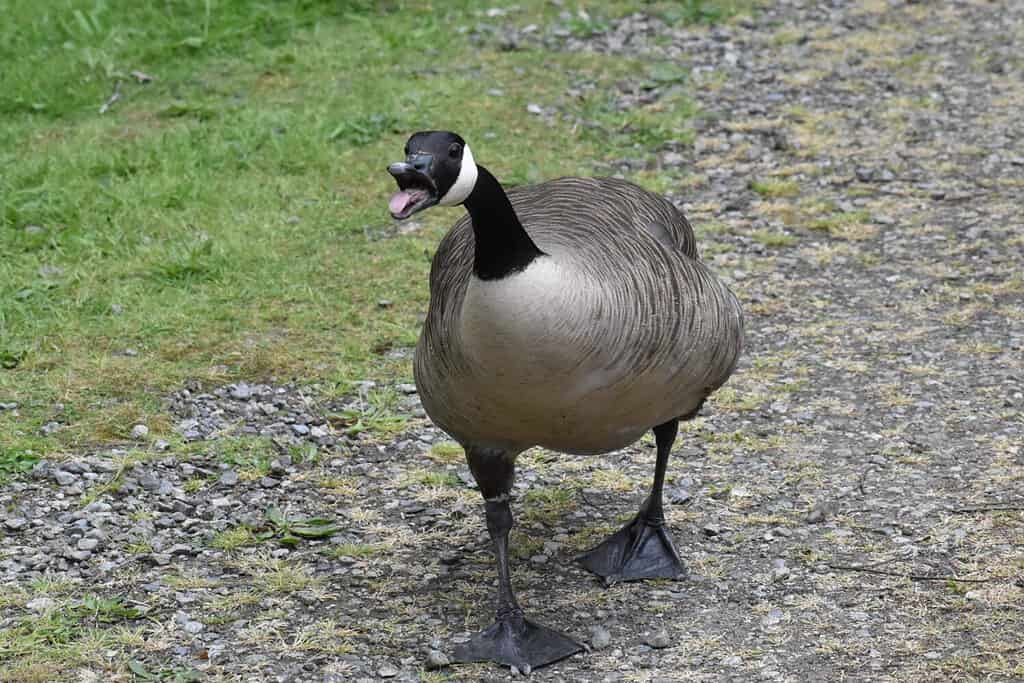
Canada geese are large with white cheeks, a brown body, and a black neck and head.
©TheBirdyStore/Shutterstock.com
Though they will protect their nest and young, they often avoid human conflict and move away if you approach them calmly.
Canadian geese are herbivores and feed on grains, aquatic plants, and grass. These geese contribute to water bodies and parks’ beauty as people enjoy birdwatching. Keep away from their nests, respect their space, and avoid feeding them. This way, you will enjoy a peaceful coexistence around these birds.
9. American Robin
The American robin is known as Turdus migratorius. These birds are familiar, lovable, and common in many areas of Canada. They have dark feathers and bright red-orange breasts, along with a melodious song. Robins hold a special place in the hearts of bird enthusiasts.
They are medium in size and are widespread and adaptable to different environments. You can find them in gardens, parks, forests, and suburban areas. Due to their migratory nature, they spend their summers in Canada, before migrating southwards during winter to warmer regions.

American robins are not harmful or a threat to humans.
©Richard G Smith/Shutterstock.com
These birds are insectivorous as they feed on insects, worms, and small invertebrates. Also, they eat fruits and berries. They are also excellent seed dispensers for various plant species, playing a significant role in ecological balance by promoting vegetation growth.
American robins are not harmful to humans. In fact, they even build their nests close to human settlements. Often, they settle on ledges, artificial structures, and trees.
These birds add liveliness and charm to Canada’s natural landscapes. At the same time, their songs set the alarm to season change while connecting people to nature.
10. White-Tailed Deer
White-tailed deer are majestic, iconic, and common throughout Canada. These deer are among the special species in the country. They are also known as Virginia deer. They have a reddish-brown coat in spring and summer and turn grey, brown in fall and winter. In addition, they have a white patch on the underside of their tail, which they raise when in danger.

White-tailed deer are harmless and do not pose any major threat to humans.
©Mircea Costina/Shutterstock.com
Bucks have amazing antlers that regrow yearly after shedding. These graceful animals are common in grasslands, woodlands, forests, and suburban areas. As browsers, they feed on fruits, grasses, leaves, and twigs, among other plant materials. They play an important role in ecological balance as they graze on vegetation.
They are harmless and do not pose any major threat to humans. On approach, they show caution by moving away. Generally, they are peaceful and prefer to rest, graze, or move in small groups.
Encounters with white-tailed deer are delightful!
11. Raccoons
These animals are North American natives, scientifically called Procyon lotor. They weigh about 10 to 20 pounds and have gray coats and dense underfur for insulation. Some of the raccoon’s outstanding features are the facial mask, dexterous front paws, and a ringed tail.
Studies show these animals as intelligent, remembering solutions to problems up to three years later. They are omnivorous, eating 33% plants, 40% invertebrates, and 27% vertebrates. Also, they are nocturnal.

Raccoons are more interested in food and somewhere to rest than harming people.
©Eric Isselee/Shutterstock.com
Due to their adaptability, they inhibit mixed and deciduous forests. Also, they extend to urban, coastal marshes, and mountainous regions. You can find them in gardens, parks, and homes.
Also, these animals have a versatile diet. They eat small mammals, insects, nuts, and garbage. This allows them to coexist well with humans. Sometimes they pose minor disturbances, like digging up lawns and tipping garbage cans.
But raccoons are not harmful to humans. They only have an interest in food and somewhere to rest.
12. Monarch Butterfly
Monarch butterflies (Danaus plexippus) are harmless wild animals in Canada. They have bright orange and black wings. They are the world’s most iconic and recognizable butterfly species.
Monarchs rely on milkweed plants as their major feeding and breeding hosts. These butterflies’ larvae feed on milkweed only. But adult butterflies rely on various plants’ nectar. They have great annual north and south migration as they fly thousands of miles.

Monarch butterflies have bright orange and black wings.
©Candy_Plus/Shutterstock.com
These butterflies are harmless and do not disturb humans. They feed via their tube-like proboscis, extracting sweet liquid from flowers. This way, they play an important part in flower pollination, promoting biodiversity.
13. Bumblebee
This is a general name for over 250 bee families from the Bombus genus. These bees are common in high latitudes and altitudes in the Northern Hemisphere. You can also find them in South America.
Most of these bees are social and live in colonies with one queen. Their colonies are small compared to those of honey bees, with about 50 individuals only. They have round hairy soft bodies giving them a fuzzy appearance.
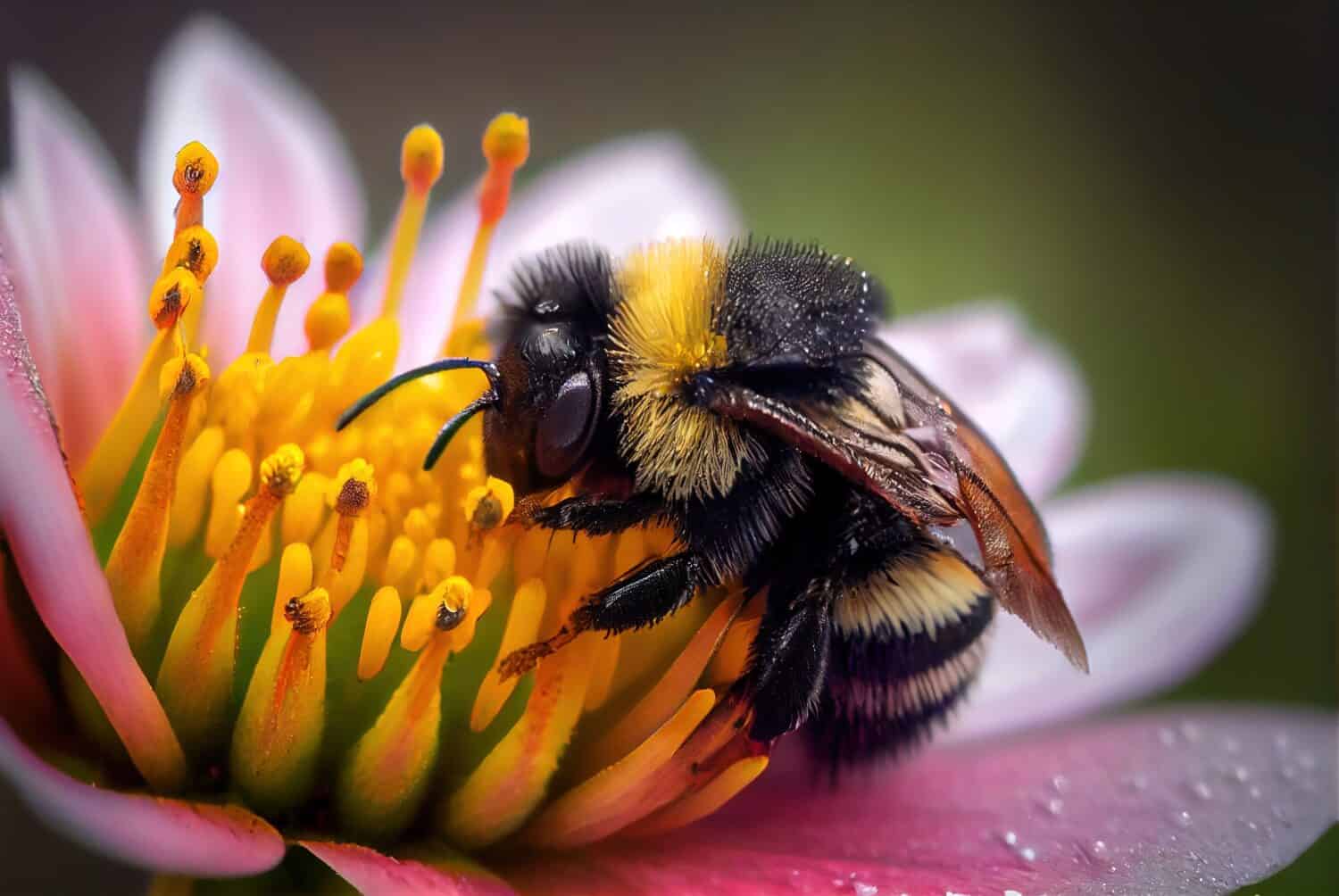
Bumblebees are non-aggressive and docile, unlike their hornet and wasp cousins.
©ArtEvent ET/Shutterstock.com
Bumblebees play an important role in the ecosystem as pollinators. Also, they are among the most harmless animals. They are non-aggressive and docile, unlike their hornet and wasp cousins.
These bees don’t sting unless you threaten or provoke them. Their sting is not as painful as those of other insects, since their focus is more on pollen and nectar than interacting with humans.
Bumblebees are delightful to observe fluttering from flower-to-flower pollinating.
14. Painted Turtle
Painted turtles are common in North America. You will find them in fresh, slow-moving water like marshes, lakes, and ponds.
Also, they prefer extensive wetlands with emergent and inundation periods. They have special adaptations to living in low temperatures. Their bodies have anti-freezing elements that prevent their cells from freezing.
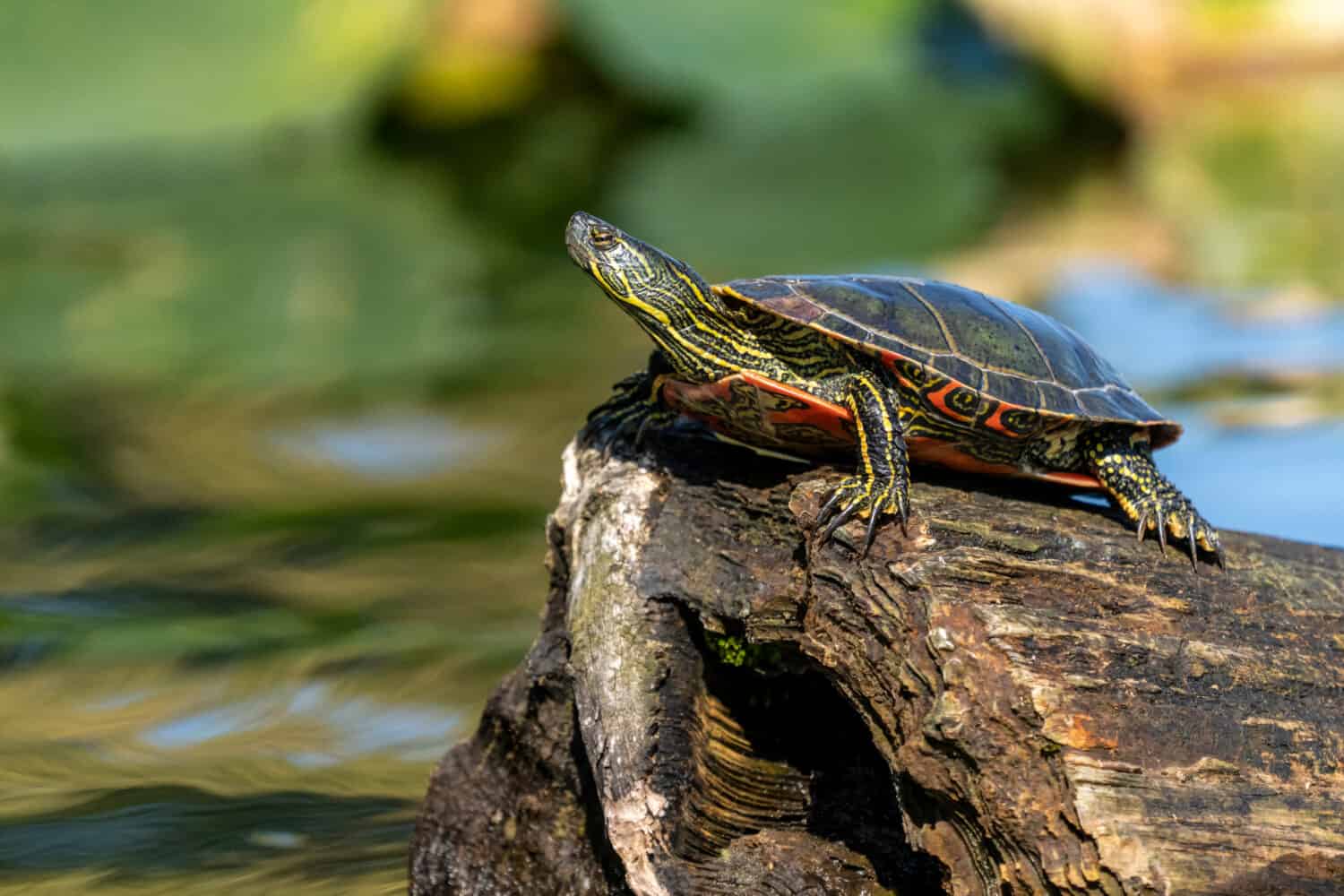
Painted turtles are harmless and captivating.
©Danita Delimont/Shutterstock.com
They feed on small water animals like fish, crustaceans, and insects. Also, they feed on algae and aquatic vegetation.
Rodents, snakes, and canines commonly eat young painted turtles and eggs. But adults have a hard shell for protection from predators.
The painted turtle is active during the day and mates between spring to autumn. In winter, it hibernates in water bodies on the muddy bottom. They will always seek safety in their shells from any incoming danger.
These turtles are harmless and captivating, with outstanding shells and a delicate appearance. They have a unique peaceful nature making them favorites among people.
15. Garter Snake
Garter snakes refer to small to medium snakes that are harmless and inoffensive. Most are from the Thamnophis genus and are Central and North American natives. They have adaptable diet variations in proximity to water bodies. That’s why they are common in Canadian provinces.
They are common in lawns, grasslands, woodlands, and fields with tall weeds. However, they don’t live far from water because they eat amphibians.

Garter snakes prefer to hide or flee when approached.
©Amrad/Shutterstock.com
They have large round eyes and pupils, rising-keeled scales, and slender bodies. Also, they have longitudinal stripes with or without spots. But some have plain bodies without stripes. Other species have yellow, blue, red, beige, black, or tan marks.
In general, these snakes are harmless since they don’t pose any threat to humans. When approached, they prefer to hide or flee. But sometimes, they may release a bad smell as a unique defense mechanism. They emit bad smells from their anal glands to put off predators.
Summary of the Most Harmless Wild Animals in Canada
The above wild animals are harmless to humans unless provoked. You should respect and admire them from a distance to avoid confrontation.
Conserving their habitats like forests, woodlands, swamps, and other places is important. Also, promote awareness and appreciation towards safeguarding them.
| Rank | Animal | Habitat |
|---|---|---|
| 1 | Canada lynx | Mountainous and boreal forests |
| 2 | Snowshoe hare | Woodlands, forests, and tundra |
| 3 | North American porcupine | Woodlands, mountains, and forests |
| 4 | Beaver | Freshwaters, lakes, rivers, and streams |
| 5 | Moose | Meadows, wetlands, and forests |
| 6 | American red squirrel | Woodlands, urban areas, and forests |
| 7 | Chipmunks | Forests, bushes, meadows, fence lines, and fields |
| 8 | Canada goose | Estuaries, lagoons, parks, and marshes |
| 9 | American robin bird | Gardens, parks, forests, sub-urban areas |
| 10 | White-tailed deer | Grasslands, woodlands, forests, and sub-urban |
| 11 | Raccoons | Mountainous regions, coastal marshes, mixed and deciduous forests, gardens, parks, and homes |
| 12 | Monarch butterfly | Milkweed and plants flowers |
| 13 | Bumblebee | High latitudes and altitudes |
| 14 | Painted turtle | Marshes, lakes, ponds |
| 15 | Garter snakes | Grasslands, lawns, woodlands, and fields |
Thank you for reading! Have some feedback for us? Contact the AZ Animals editorial team.








